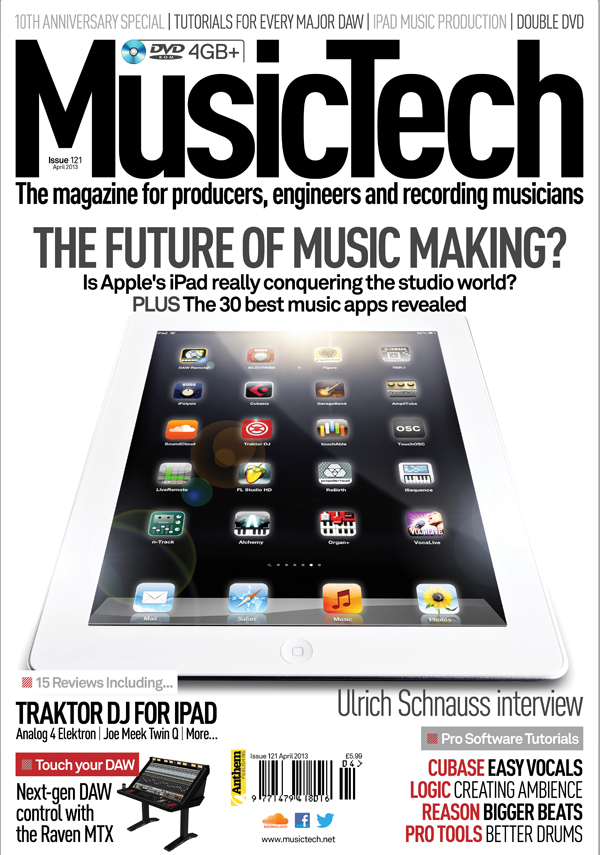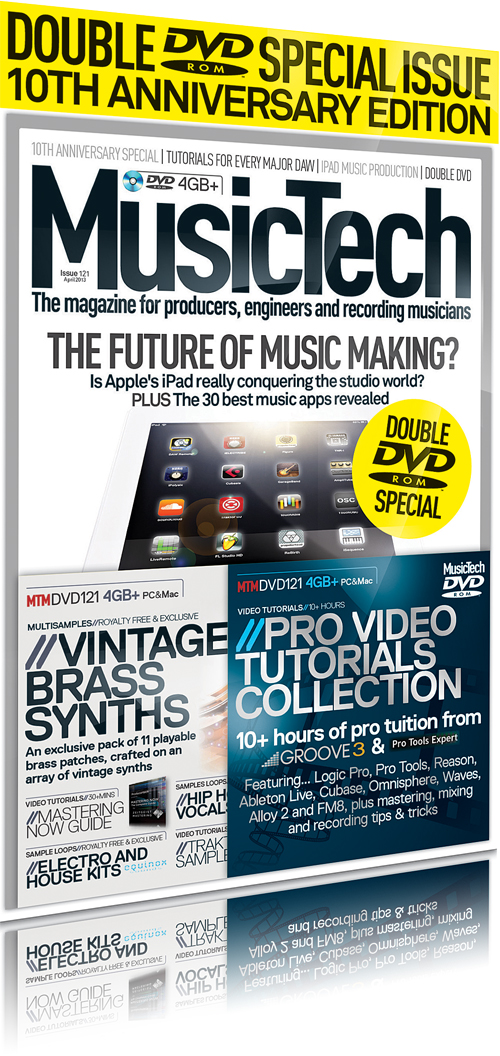Music Tech Magazine Issue 121 – Tenth Anniversary Special
The TENTH ANNIVERSARY ISSUE of MusicTech Magazine is on sale now! Join new editor Andy Jones and the team as we bring you our TENTH ANNIVERSARY ISSUE! This Month’s Features The Future of Music Making? When Apple opened up the iOS platform to third-party developers in 2008 with iOS 2, no one could have guessed […]

 The TENTH ANNIVERSARY ISSUE of MusicTech Magazine is on sale now!
The TENTH ANNIVERSARY ISSUE of MusicTech Magazine is on sale now!
Join new editor Andy Jones and the team as we bring you our TENTH ANNIVERSARY ISSUE!
This Month’s Features
The Future of Music Making?
When Apple opened up the iOS platform to third-party developers in 2008 with iOS 2, no one could have guessed the extent to which it would change the way we used our devices and thought about mobile computing. At the beginning, most apps were fairly simple, but as time went on the hardware and operating system became increasingly sophisticated. It wasn’t until the release of the iPad in 2010, however, that the full potential of touchscreen devices really started to become apparent. Since then, the iPad has become incredibly popular – to date Apple has shifted almost 100 million of them. And as music apps have matured from being toy-like to being much more serious, that means a whole lot more potential musicians out there. This month we’ve got an in depth feature analysing the growth of iOS based music making. As Apple’s all-conquering iOS devices find their way into the hands of more and more musicians we explore the potential of the iPad for ultra-portable music-making.
Max For Live
Max for Live enables you to augment the Live environment in ways that would otherwise exist only in your imagination. You can use it to make your own instruments, effects and visuals that seamlessly integrate with Live. You can communicate with hardware and tinker with elements of the Live application itself, altering the way you control your session and what your session controls. This month we’ll take you through this remarkable addition to Ableton’s Live 9
Ulrich Schnauss Interviewed
Over the last decade, Ulrich Schnauss has become one of the biggest names in electronic music circles thanks to some intoxicatingly atmospheric productions that display somewhat opposing characteristics, being both melancholic yet euphoric, downbeat yet uplifting. His tunes have ensnared an increasing number of chin-stroking fans and, once bitten, you’ll find it hard not to hoover up the man’s complete output. And when did that last happen to you? Our new editor Andy Jones sits down with Ulrich – the master of shoe-gazing electronica and, somewhat surprisingly, unearths a veritable museum of music technology along the way.
Our Ten Minute Master this month looks at the often overlooked but essential ergonomics of the home studio, there is an all too depressing trend of pro studios closing their doors. As such, many of us are now working from adapted rooms at home. The difference between the professional and home studio is likely to be the bespoke design, both acoustically and ergonomically. Acoustically, professionally designed rooms support the delivery of accurate and detailed sound. Nowadays, there is a range of options you can install at home that will help to tame and control the acoustic issues you face. This month we explore the best methods to create the ergonomically perfect studio.
Studio Icons this month looks at the EMS VCS3: Back in 1969, when the EMS VCS 3 was launched, analogue synthesizers were very new to the recording scene. Manufacturers such as Moog and ARP led the way with their large modular machines; however, in addition to size, they cost a small fortune, pricing them out of the reach of all but the most prosperous studios and wealthy rock stars. With the VCS 3 (Voltage Control Studio 3), Peter Zinovieff’s London-based Electronic Music Studios company produced arguably the first portable synth. We look back at this remarkable piece of technology.
This Months’ Tutorials
Our Cubase 7 Tutorial this month covers easy vocal editing. In Cubase 7, VariAudio 2.0 takes things to the next level. The two biggest changes are the ability to create harmonies quickly and easily, and to edit multiple VariAudio parts in the same editor window. This month we explore why these could be important to your productions.
Our Logic Pro 9 Tutorial covers crafting and creating ambiences.Sculpture is undoubtedly one of the most intriguing tools in Logic’s palette of synthesizers, but it’s an instrument that possibly doesn’t have the immediacy of something like the ES2. Musically speaking, Sculpture is a great way of creating ambient, ‘other-worldly’ sounds that subtractive synthesis can rarely produce. We’ll show you how
Our Pro Tools Tutorial explains how to create better drum sounds. Giving a drum track real presence in the mix is a task that’s made much easier if you take advantage of Pro Tools’ Channel Strip plug-in.
Our Reason Tutorial will show you how to make bigger beats. Reason is blessed with some of the best beat-making tools of any DAW. Hollin Jones gets to grips with them in this month’s tutorial.
PLUS
Plus our new feature Advance brings you the latest news and announcements from the world of music technology
DVD Contents
Our twoDVDs this month include all you need to inject some retro sounds into your tracks with this month’s exclusive pack of vintage brass instruments or go more contemporary with cutting-edge beats, melodic riffs and chopped-up vocals…
Vintage Brass Synths Although there’s nothing quite like the sound of a real brass instrument, there’s also something rather satisfying about the round and resonant sounds of synthesised brass instruments and ensembles. Our friends at PinkNoise Studio have whipped up 11 different multisampled synth brass patches utilising an array of synths.
Electro, Progressive and House Kits With the boundaries of dance genres constantly shifting, the elements found in house, electro and progressive styles are often interchangeable. With that in mind, Equinox Sounds has provided six melodic dance music construction kits at 128 and 132BPM. MIDI files are included so you can load the melodies and progressions into your tracks and try out your own sounds.
Ulrich Schnauss Studio Tour Synth lovers prepare to be jealous as we take a studio tour with German electronic musician and producer Ulrich Schnauss, best known for his multilayered, deep and melodic music, particularly on early albums Far Away Trains Passing By and A Strangely Isolated Place. Schnauss’ studio houses a huge array of classic synths including an Oberheim 8 Voice, Yamaha DX7 with rare DX Programmer, Waldorf Wave, Elka Synthex and Rhodes Chroma, plus walls of rackmounted outboard kit.
Plus on our second disc We’ve teamed up with Groove 3and Pro Tools Expert to deliver a massive collection of tutorial videos and podcasts totalling well over ten hours! A huge range of software and techniques is covered, including Logic Pro, Pro Tools, Reason, Ableton Live, Cubase 7, Omnisphere, Waves, Alloy 2 and FM8, plus mastering, mixing and recording tips. You’ll also find six podcast interviews featuring Universal Audio, Rupert Neve Designs, Focusrite, Slate Digital, Munro Acoustics and the Music Producers Guild.
and much much more!
ISSUE 121 IS ON SALE NOW! CLICK HERE TO BUY!